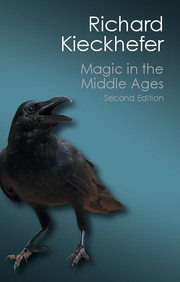Book contents
- Frontmatter
- Contents
- List of illustrations
- Foreword to the Canto edition
- Preface
- 1 INTRODUCTION: MAGIC AS A CROSSROADS
- 2 THE CLASSICAL INHERITANCE
- 3 THE TWILIGHT OF PAGANISM: MAGIC IN NORSE AND IRISH CULTURE
- 4 THE COMMON TRADITION OF MEDIEVAL MAGIC
- 5 THE ROMANCE OF MAGIC IN COURTLY CULTURE
- 6 ARABIC LEARNING AND THE OCCULT SCIENCES
- 7 NECROMANCY IN THE CLERICAL UNDERWORLD
- 8 PROHIBITION, CONDEMNATION, AND PROSECUTION
- Further reading
- Index
3 - THE TWILIGHT OF PAGANISM: MAGIC IN NORSE AND IRISH CULTURE
Published online by Cambridge University Press: 05 October 2014
- Frontmatter
- Contents
- List of illustrations
- Foreword to the Canto edition
- Preface
- 1 INTRODUCTION: MAGIC AS A CROSSROADS
- 2 THE CLASSICAL INHERITANCE
- 3 THE TWILIGHT OF PAGANISM: MAGIC IN NORSE AND IRISH CULTURE
- 4 THE COMMON TRADITION OF MEDIEVAL MAGIC
- 5 THE ROMANCE OF MAGIC IN COURTLY CULTURE
- 6 ARABIC LEARNING AND THE OCCULT SCIENCES
- 7 NECROMANCY IN THE CLERICAL UNDERWORLD
- 8 PROHIBITION, CONDEMNATION, AND PROSECUTION
- Further reading
- Index
Summary
Norse tradition tells of a conflict between two earls of tenth-century Norway in which both the parties, named Hakon and Thorleif, resorted to magic. Thorleif disguised himself as a beggar, went to the court of Hakon, and under the pretense of singing a poem in his honor recited a curse that caused Hakon to lose his beard and much of his hair, to itch uncontrollably between his legs, and to suffer a lingering illness. In revenge, Hakon invoked the goddesses Thorgerd and Irpa, who aided him with their “trollish and prophetic powers.” They made a human figure out of driftwood, placed a heart inside it, and sent it to Thorleif, who promptly died.
Our source for all this is a literary account, not a straightforward history. Indeed, the earliest recorded version of the tale is from the fourteenth century, and what it attests is not the actual practice of magic in pre-Christian Scandinavia but rather the recollection of that magic at a time when it could arouse a mixed reaction, combining horror with amusement. Precisely in this respect, however, the story gets to the heart of the problem in working with the pre-Christian magic of northern Europe: most of our information comes from after the conversion, and our fullest sources are fictional accounts that combine actual magical practice with fanciful embellishments.
- Type
- Chapter
- Information
- Magic in the Middle Ages , pp. 43 - 55Publisher: Cambridge University PressPrint publication year: 2014



